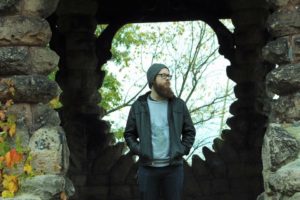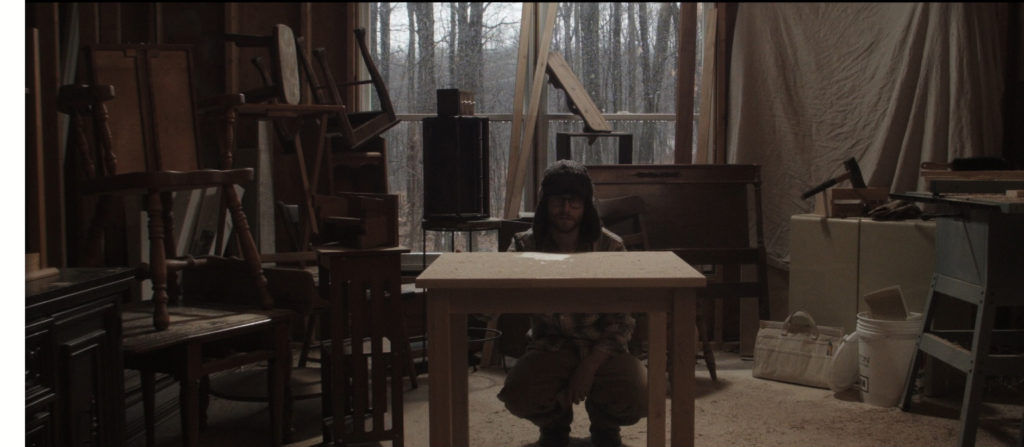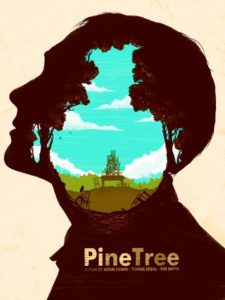Showcase Filmmaker Spotlight: Adam Evans
Showcase Filmmaker Spotlight: Adam Evans
By Travis Trew, Programming Associate

Hailing from Reading, PA, filmmaker Adam Evans’s credits include producing or directing several short docs, including Philly Film Showcase slum The Witmans. He wrote and directed the narrative short Pine Tree, which follows a carpenter named Ryan (Tobias Segal) who struggles to let go of his carefully honed pieces when they’re finished, despite the encouragement of his girlfriend Florence (Dre Davis). It’s a meditative look at the difficulty of making and sharing art, loosely inspired by Evans’s own journey to find his voice as a filmmaker. Evans gives this relatable subject matter a magical realist twist when one of the protagonist’s tables begins to speak (and hum).
PFS: Even though Pine Tree is about a carpenter and not a filmmaker, you’ve said that the film has a lot of personal resonance for you. Where did the idea for the film come from?
AE: I’d gotten into Temple and suddenly found myself in classes with people who had been doing film their entire lives. Since elementary and middle school they’d had a camera and were making a lot of films. I had never really touched a camera outside of photographic cameras. So here I am at Temple, which I’d worked really hard to get into. I’m in class with all these people and my work is probably not as good as their work. After being at Temple, I’d found myself absolutely hating screenings. I hated showing my work to other people, to the point where in some classes I’d get up and leave the room when my work was showing. It was just a really terrifying experience to be sitting in a room with all these other people watching your film. Just the sound—or lack of sound—that comes from people watching a film made me almost paranoid. But through the process of being in school and doing a lot of work I discovered that that idea of insecurity is not really unique to me; that insecurity is out there with pretty much any artist that I’ve talked to. So I started thinking about that and wanted to do something that reflected that, because it’s something that a lot of artists don’t really talk openly about. I’d also landed on this idea of magical realism, which I’m super interested in.
PFS: How did magic realism influence you as you were writing the film? How did you decide to have something fantastical happen within this realistic context?
AE: I think it actually came about with my love of Hayao Miyazaki films like Spirited Away. And even some of Japanese Neorealism stuff like Ozu’s Tokyo Story, where it’s a really focused slice-of-life piece where we’re following people and nothing really happens but it’s interesting to be with them. And with Miyazaki you have this magical element introduced. In a lot of his films, there’s not really a villain and there’s not really a plot per se like “this character has to do this in order to do this.” I became really interested in that idea. One of my biggest influences, visually, is Wes Anderson. I love his work, and all of his stuff has this very specific style to it. It’s not necessarily that there’s magical realism in there, it’s that his work features this off-kilter, quirky style that, for whatever reason, kind of meshed with me. I think that’s the beauty of film: that you can feature crazy elements in stories and do it in a way that it is grounded in our reality and features some things that we’ve maybe never seen before. My philosophy about film is that it’s a visual medium, and I think that my end goal in my career is to make a film that is entirely silent. To make something that somebody can understand fully, without using dialogue. I think that’s super impressive, and it’s something I would love to do. This idea of magical realism adds so many elements stylistically that are not traditional, that are really interesting and can tell stories in ways that are not verbal. So I guess non-verbal film would be the correct term rather than “silent.”
PFS: That makes a lot of sense in relation to the film, and is also ironic because the movie is about a table that talks.
AE: Yeah, and in a lot of ways I feel like the table says more in some situations than the main characters do.

PFS: How did you decide what the table would sound like?
AE: That was actually super, super tough, and that didn’t get settled on until after the film was shot and almost edited. It was something that my producers and I were talking about from the start. There were tons of drafts of the script. It even varied in terms of how sentient the table was. In one of the first drafts of the film it was actually a wisecracking table, and they went on a road trip. It was completely different than what ended up being onscreen. In terms of what it ended up sounding like, we decided that it would be pretty interesting if the voice were my own. So that voice is actually mine. And nobody would know that unless they knew me. But it was kind of a meta element that I thought was interesting.
PFS: The film doesn’t hit you over the head with style in a Wes Anderson way, but it does have that cohesiveness of look and feel. How much had you visualized beforehand and what were you going for?

AE: I use Wes Anderson as an influence but you’re right, it doesn’t stand out like his. What I take from him is threefold: production design is super important, music is really important, and, strangely enough, thinking about outside artwork like poster artwork is super important. I was writing for a pop culture website that did daily showcases of artists, and I’d found this artist, Mike Rogers, who goes by Big Bad Robot. And I loved his work. So on an off chance I reached out to him and I said, “Hey I’m writing this film would you be interested in working on it and coming up with a poster for it?” He was really interested, it resonated with him, and we ended up working together. He really captured, I think, an impressive vision of what the story is. With music in my film I sort of take influences from a lot of people. I wanted to convey this idea that a relationship can be between two people who come from entirely different worlds. So you have the main character Ryan, who is really this nature-focused person. All of his clothing is very natural-toned. And with that the music I wanted for the score was this folky sound. But with the female character, Florence, for her music I was looking at more like modern future-pop, like Grimes, and CHVRCHES, and Purity Ring—all of these artists who are using synthy, atmospheric tones. My composer Erik Rodriguez, who goes by Erbear online, really meshed the folk and future pop sounds to create a pretty unique sound. And that kind of split between who the characters were and where they came from also played into production design. I’d worked really closely with my production designer thinking about colors. The main character Ryan uses these earthy, woodsy colors, but then you have these hints of teal and green with Florence. There’s this color seeping in which is representative of her bringing a little bit of light to his life. There are also a lot of animal references throughout the film. He’s representative of a deer stag so on his hat he has a deer, on his sweater there’s a deer. And she’s like an owl, so owl iconography is all over the film. Looking at those sorts of things—even though it might not be obvious to someone the first time—I think is really important and develops that style.
PFS: What’s the experience been like of finishing this film and sharing this film that’s in a lot of ways about the difficulty of sharing your work?
AE: It’s sort of been a cathartic experience. It’s really, really personal to me. It’s weird because I always feel cheesy saying that. At the end of the day it’s a film about a talking table, which is a really weird, nontraditional way to go. And I love that about it. I would say that being weird is great and this film is really representative of me and my style. But showing it and having people be receptive to it has been really positive. It’s played at a couple festivals and won a couple awards. It’s always really interesting because the people who tend to come up to me afterward and ask me about it and relate to it are other filmmakers. I think it’s great that general audiences appreciate it. But at the end of the day to have other filmmakers whose work I really respect and am impressed by come up and say, “Yeah I got that, I’m right there with you,” is really important. It makes me feel like I’m not alone and I’m sure it makes them feel like they’re not alone in their work.
Pine Tree will screen on Friday, June 9th at the Prince Theater’s Black Box as part of Philly Film Showcase, an exhibition supporting new work by talented, up-and-coming local filmmakers.